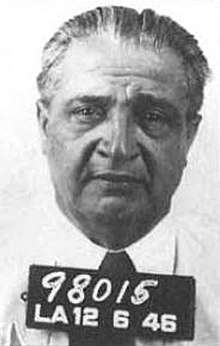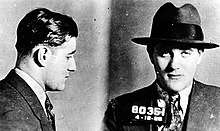Jack Dragna
Jack Ignatius Dragna[1] (born Ignazio Dragna, Italian pronunciation: [iɲˈɲattsjo ˈdraɲɲa]; April 18, 1891 – February 23, 1956) was an American Mafia member and Black Hander who was active in both Italy and the United States in the 20th century. He was active in bootlegging in California during the Prohibition Era in the United States. In 1931, he succeeded Joseph Ardizzone as the boss of the Los Angeles crime family after Ardizzone's mysterious disappearance and death. Both James Ragen and Earl Warren dubbed Dragna the "Capone of Los Angeles". Dragna remained the boss of the Los Angeles crime family from 1931 until his death in 1956.
Jack Dragna | |
|---|---|
 Mugshot of Dragna in 1946. | |
| Born | Ignazio Dragna April 18, 1891 |
| Died | February 23, 1956 (aged 64) Los Angeles, California, U.S. |
| Nationality | Italian |
| Other names | Charles Dragna, Antonio Rizzotto |
| Occupation | Crime boss |
| Spouse(s) | Francesca Dragna ( m. 1922) |
| Children | 2 |
| Relatives | Tom Dragna (brother) Louis Tom Dragna (nephew) |
| Allegiance | Los Angeles crime family |
Biography
Early life
Dragna was born to Francesco Paolo Dragna and Anna Dragna in Corleone, Sicily, on April 18, 1891. On November 18, 1898, Dragna came to the United States on the S.S. Alsatia with his mother, older sister Giuseppa, and older brother Gaetano.[2] They stayed in Brooklyn with Antonio Rizzotto's family, also from Corleone. It is unknown when Dragna's father arrived in the United States. Dragna stayed in New York for ten years before returning to Sicily. As a young man, he joined the Italian Army and later the Sicilian Mafia.
In 1914, Dragna returned to America. He appears to have had a relationship with Gaetano Reina, who eventually would lead his own crime family in Manhattan and the Bronx. That same year, Dragna was a suspect in the murder of Jewish poultry dealer Barnet Baff. After the killing, Dragna fled to California and assumed the name Charles Dragna. Dragna was extradited to New York, but never went on trial. In 1915, Dragna was arrested for Black Hand extortion of a Long Beach man and served three years in prison. At the time of his extortion arrest, Dragna was using the alias Ignazio Rizzoto.
During the Prohibition Era, Dragna and his brother Gaetano (now named Tom) ran extortion and illegal liquor distillation operations. Ignazio Dragna now became Jack Ignatius Dragna. In 1922, Dragna married Francesca Rizzotto.[3] After his prison stint he worked closely with Joseph Ardizzone, a prominent mobster in Los Angeles.
Mafia Don
In 1931, Dragna succeeded Joseph Ardizzone as boss of the Los Angeles crime family. It was rumored that Dragna participated in Ardizzone's disappearance/death. The American Mafia wanted to make inroads in California, and supported Dragna, as opposed to the "Mustache Pete" Ardizzone. His brother Tom became his consigliere. He also had several relatives working in the crime family, but aside from his brother, his nephew Louis Tom Dragna (Tom's son) was the only other person heavily involved in the family.
As boss, Dragna's chief source of income came from extorting local bookmakers for "protection" money, although he was also the main illegal gambling operator in the city. Other businesses including running gambling ships, a heroin smuggling operation, and collecting extortion money. His close supporters included Girolamo "Momo" Adamo and John Roselli. Roselli had been a member of the Chicago Outfit, but left for California and worked with Dragna in gambling.[4] In the 1950s, Roselli left California and became the Mafia's main representative in Las Vegas. An old bootlegging associate of Dragna's, Anthony Cornero ran gambling ships off the coast of California. Tommy Lucchese, of the Lucchese crime family, was Dragna's main contact in New York (and the two were relatives according to Mickey Cohen). Dragna also controlled unions in the laundromat business and dress importing companies.[5]
Siegel and Cohen

As boss, Dragna often had to do business with representatives from the more powerful Cosa Nostra families in New York. When Benjamin "Bugsy" Siegel, an associate of the New York Luciano crime family, relocated to the West Coast during the late 1930s, he started his own rackets and formed an uneasy relationship with Dragna. Siegel brought in much more income for the Los Angeles family and generated a great deal of 'respect', which Dragna resented. Although many sources speak of a rivalry between them, Dragna and Siegel worked closely together, especially at organizing a racing wire service on the West Coast.[6]
In June 1947, the East Coast crime families murdered Siegel in Los Angeles due to his failure to properly manage the new Flamingo Hotel in Las Vegas. Mickey Cohen, who had been serving as Siegel's bodyguard, immediately took over Siegel's rackets and refused to accept Dragna's authority. Dragna ordered several murder attempts on Cohen, but he managed to survive them all. On February 14, 1950, the California Commission on Organized Crime singled out Dragna as the head of a crime syndicate that controlled crime in Southern California.[7] Soon after, several Los Angeles family members were arrested for the bombing of Mickey Cohen's home. Dragna fled the state to avoid questioning. He later surrendered to authorities, and was questioned in the U.S. Senate Kefauver hearings, but denied all accusations against him.[8] Cohen was also questioned in the hearings, and as a result was convicted of federal tax evasion and was forced to give up control of his rackets to the Los Angeles family.
Private life and death
In 1953, the federal government ordered Dragna to be deported to Sicily. Back in 1932, Dragna had violated immigration law by illegally entering the United States at the San Ysidro border crossing in San Diego after a three-day stay in Mexico.[9] However, at the time of his death Dragna was still living in California, appealing against the deportation order.
Dragna was a very private boss who eschewed flashiness and attention. However, in the 1950s, the Los Angeles Police Department (LAPD) under Chief William H. Parker engaged in a campaign of harassment against organized crime figures. Dragna and his family were frequently arrested. When his wife Frances died in 1953, Dragna lost interest in running the Los Angeles family and instead focused on meeting new women. On one occasion, several members of the LAPD stationed themselves outside a trailer where Dragna and a girlfriend were having sex. Using listening devices, officers gained enough evidence to arrest Dragna for engaging in lewd acts.
On February 23, 1956, Dragna died of a heart attack in Los Angeles. His body was interred at Calvary Cemetery in East Los Angeles, California. Dragna was survived by two children. His son Frank Paul Dragna was a USC graduate and World War II veteran[10] who lost an eye in the war and was nicknamed "One Eye" to distinguish him from his cousin who had the same name ("One Eye" also had a glass eye).[11] Dragna had a daughter Anna Rosalia Dragna, who later married and changed her surname to Niotta.
In popular culture
- Dragna appears as a character in James Ellroy's fictional L.A. Quartet novels, specifically The Big Nowhere (1988) and White Jazz (1992).
- Though he does not make an actual appearance, he is mentioned several times in the video game L.A. Noire.
- A character by the same name appears in the sixth episode of the second series of the 1960s cult British spy-fi tv series The Avengers portrayed by Reed De Rouen.
- Dragna appears in the 2013 film Gangster Squad, where he is played by actor Jon Polito.
- In the 1991 film Bugsy, the highly fictionalized story of Bugsy Siegel, Dragna is played by Richard C. Sarafian.
- Paul Ben-Victor plays Dragna in the neo-noir 2013 TV series Mob City.
Sources
- "DRAGNA HELD FOR OUSTER - McGranery Says Californian Will Be Deported as Racketeer". The New York Times. 1952-12-08. Retrieved 2012-07-09.
- Passenger Manifest for the S.S. Alsatia, 18 November 1898, available at Ellisisland.org.
- "Jack Ignatius Dragna and Frances Rizzotto, 1922". California, County Marriages, 1850-1952. FamilySearch. Retrieved 2014-01-16.
- Goldsmith, John A. "Chapter 4: Organized Crime" (PDF). p. 59.
- Tyler, Gus (1967). Organized crime in America: a book of readings. University of Michigan Press. Retrieved 2012-07-09.
- Redston, George; Crossen, Kendell F. (1965). The Conspiracy of Death. Bobbs-Merrill. Retrieved 2012-07-09.
- "L.A. Police Raid Home of Dragna". Eugene Register-Guard. 1950-02-13.
- "The Crime Front". St. Petersburg Times. 1950-02-14. p. 6.
- "Dragna to Fight Deportation". Sarasota Herald-Tribune. 1953-03-03. p. 13.
- "Frank Dragna Sues Police for $350,000 in Damages". Los Angeles Times. 1950-04-08. Retrieved 2012-07-09.
- Messing, Philip (2007-10-07). "Inside Feds' Mafia-Pedia". New York Post. Retrieved 2012-07-09.
References
- Demaris, Ovid. The Last Mafioso: The Treacherous World of Jimmy Fratianno. Bantam Books, 1981. ISBN 0-553-27091-5
- Fisher, David. Joey the Hitman: The Autobiography of a Mafia Killer. Da Capo Press: Massachusetts, 2002. ISBN 978-1-56025-393-8
- Lewis, Brad, Hollywood's Celebrity Gangster. The Incredible Life and Times of Mickey Cohen, Enigma Books: New York, 2007. ISBN 978-1-929631-65-0
- Sifakis, Carl. The Mafia Encyclopedia, Third Edition, Checkmark Books: New York, 2005. ISBN 978-0-8160-5695-8
- Warner, Richard N. "The First Mafia Boss of Los Angeles? The Mystery of Vito Di Giorgio, 1880-1922." On The Spot Journal (Summer 2008), 46-54.
- Dragna background (Part I) at Crimefile. Copyright Gatecitypublishing, 2010.
Further reading
- Buntin, John (2009). L.A. Noir: The Struggle for the Soul of America's Most Seductive City. New York: Harmony Books. ISBN 9780307352071. OCLC 431334523. Retrieved 13 October 2014.
External links
| American Mafia | ||
|---|---|---|
| Preceded by Joseph Ardizzone |
Los Angeles crime family Boss 1931-1956 |
Succeeded by Frank DeSimone |
| Preceded by ? |
Los Angeles crime family Underboss 192?-1931 |
Succeeded by Momo Adamo |